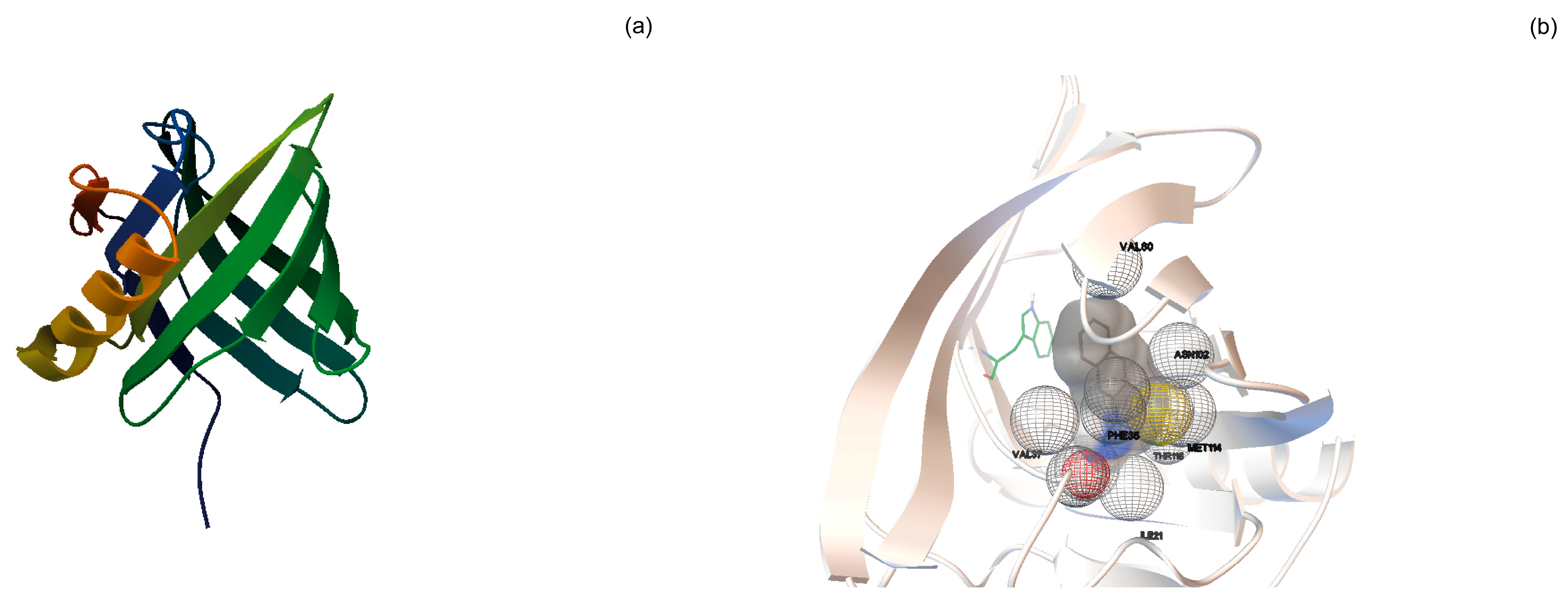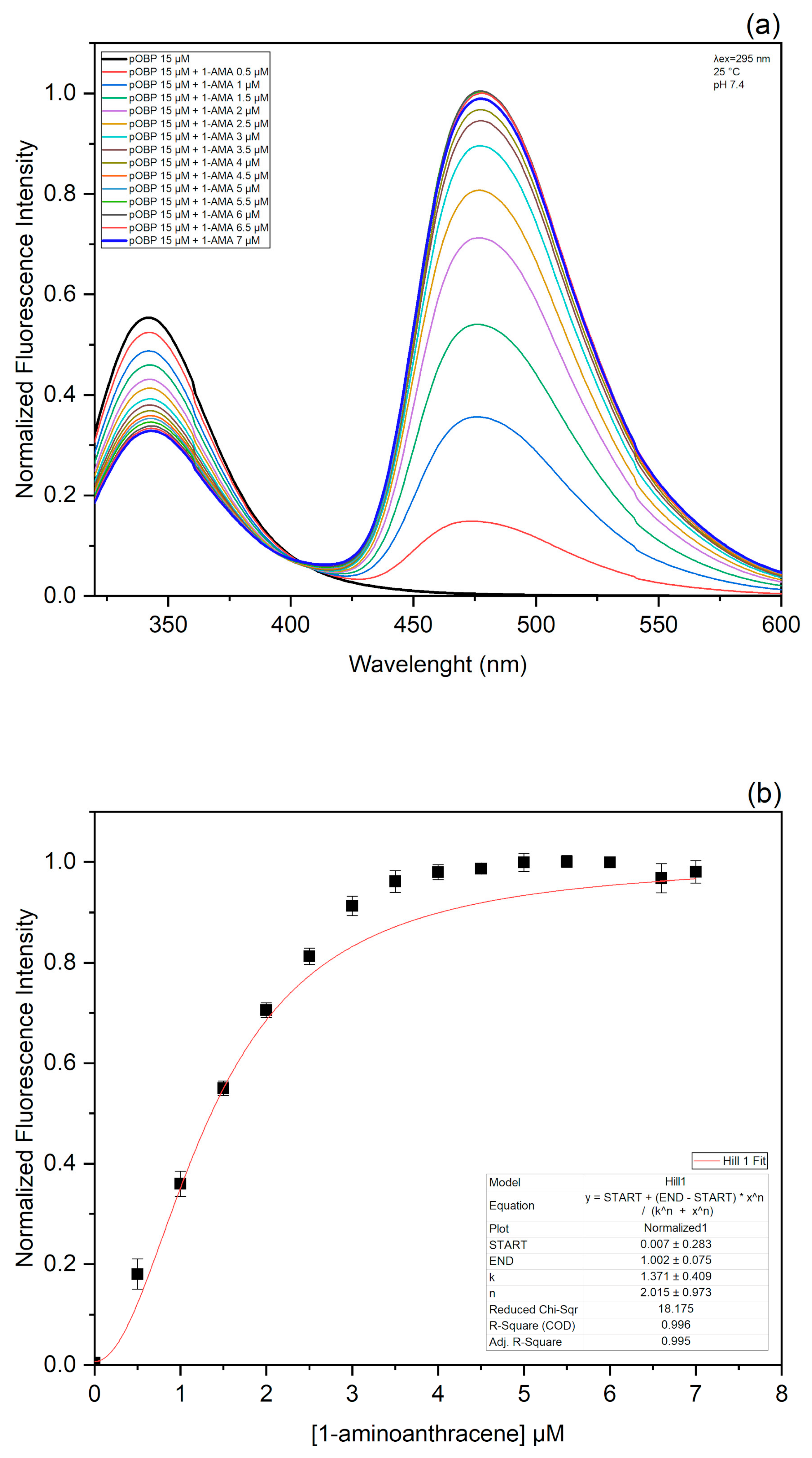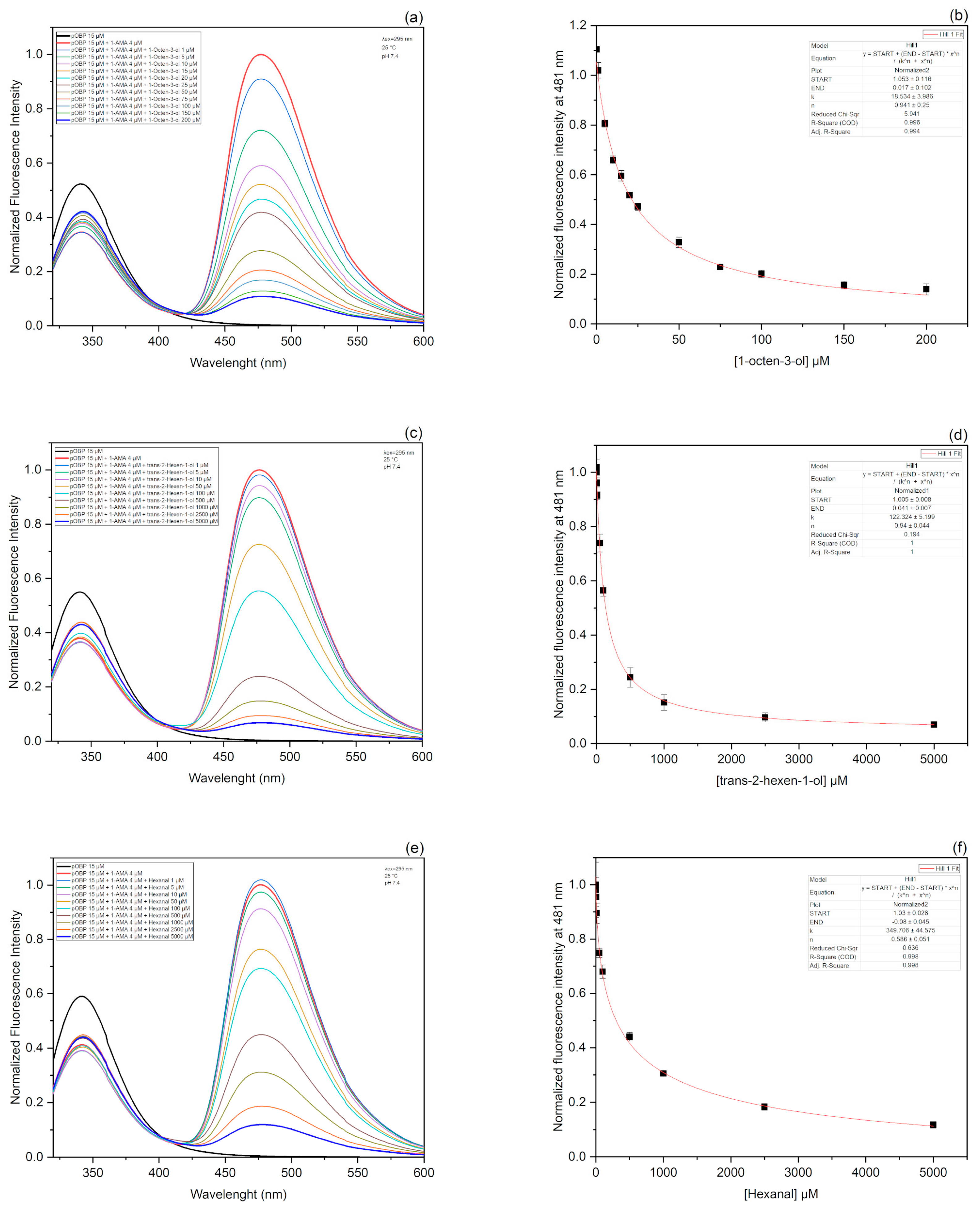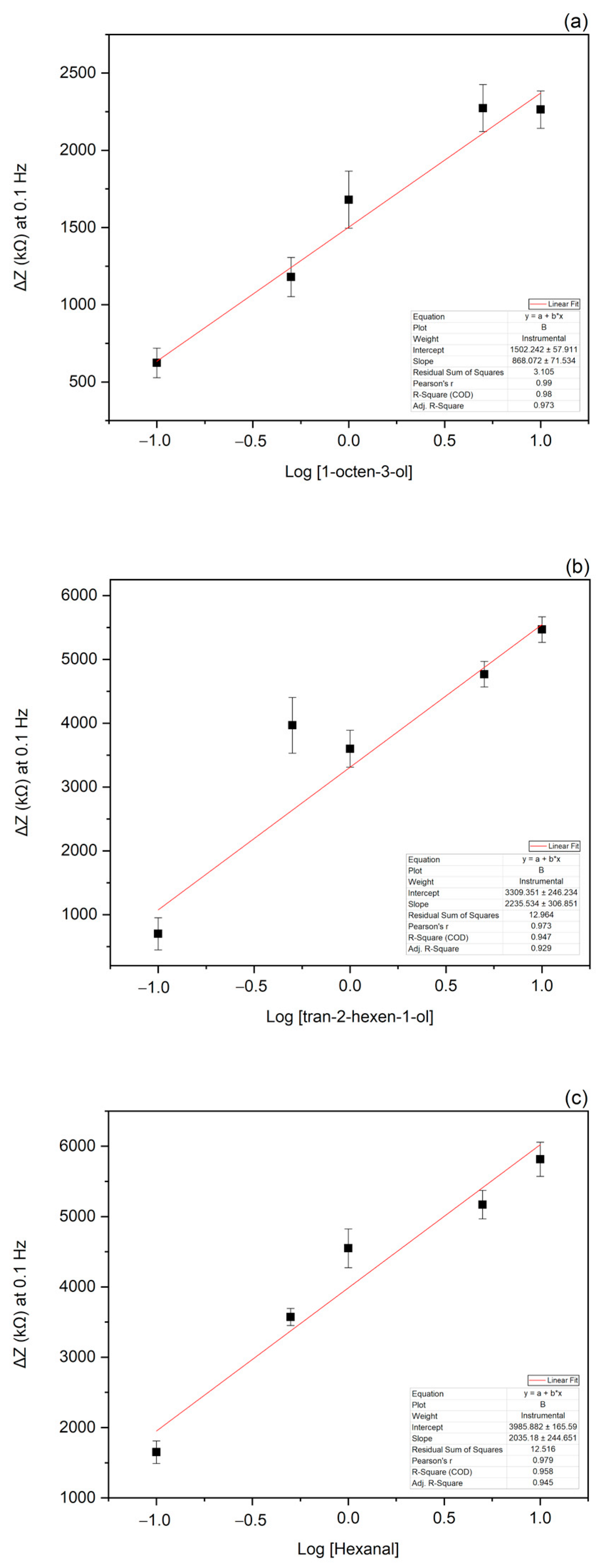An Impedimetric Biosensor for Detection of Volatile Organic Compounds in Food
Abstract
1. Introduction
2. Materials and Methods
2.1. Materials
2.2. Direct Docking Analysis
2.3. Expression and Purification of Recombinant pOBP
2.4. Expression and Purification of Glutamine-Binding Protein
2.5. Fluorescence Spectroscopy
2.6. Instruments for Electrochemical Experiments
2.7. Surface Derivatization and Functionalization
2.8. Impedance Measurements
2.9. Statistical Analysis
3. Results and Discussion
3.1. Fluorescence Spectroscopy Measurements
Competitive FRET Assay
3.2. Functionalization and Immobilization of pOBP on Sensor Surface
3.3. Electrochemical Characterization
3.4. EIS Experiments in Gas
4. Conclusions
Supplementary Materials
Author Contributions
Funding
Institutional Review Board Statement
Informed Consent Statement
Data Availability Statement
Conflicts of Interest
References
- Garcia, S.N.; Osburn, B.; Russell, M.T.J. One Health for Food Safety, Food Security, and Sustainable Food Production. Front. Sustain. Food Syst. 2020, 4, 1–9. [Google Scholar] [CrossRef]
- Whitfield, F.B. Microbiology of food taints. Int. J. Food Sci. 1998, 33, 31–51. [Google Scholar] [CrossRef]
- Springett, M.B. Formation of off-flavours due to microbiological and enzymic action. In Food Taints and Off-Flavours; Saxby, M.J., Ed.; Springer: Boston, MA, USA, 1996; pp. 274–289. [Google Scholar] [CrossRef]
- Whitfield, F.B. 5—Microbiologically derived off-flavours. In Taints and Off-Flavours in Food, 1st ed.; Baigrie, B., Ed.; Woodhead Publishing: Sawston, UK, 2003; pp. 112–139. [Google Scholar] [CrossRef]
- Lord, T. 4—Packaging materials as a source of taints. In Taints and Off-Flavours in Food, 1st ed.; Baigrie, B., Ed.; Woodhead Publishing: Sawston, UK, 2003; pp. 64–111. [Google Scholar] [CrossRef]
- Koszinowski, J.; Piringer, O. Evaluation of off-odors in food packaging—The role of conjugated unsaturated carbonyl compounds. J. Plast. Film Sheeting 1986, 2, 40–50. [Google Scholar] [CrossRef]
- Valero, E.; Villamiel, M.; Miralles, B.; Sanz, J.; Martínez-Castro, I. Changes in flavour and volatile components during storage of whole and skimmed UHT milk. Food Chem. 2001, 72, 51–58. [Google Scholar] [CrossRef]
- Choe, E.; Min, D.B. Chemistry and reactions of reactive oxygen species in foods. Crit. Rev. Food Sci. Nutr. 2006, 46, 1–22. [Google Scholar] [CrossRef] [PubMed]
- Gottschalk, G. Bacterial Metabolism, 2nd ed.; Springer: New York, NY, USA, 1986. [Google Scholar] [CrossRef]
- Saier, M.H., Jr. Multiple mechanisms controlling carbon metabolism in bacteria. Biotechnol. Bioeng. 1998, 58, 170–174. [Google Scholar] [CrossRef]
- del Castillo-Lozano, M.L.; Mansour, S.; Tache, R.; Bonnarme, P.; Landaud, S. The effect of cysteine on production of volatile sulphur compounds by cheese-ripening bacteria. Int. J. Food Microbiol. 2008, 122, 321–327. [Google Scholar] [CrossRef] [PubMed]
- Kadota, H.; Ishida, Y. Production of volatile sulfur compounds by microorganisms. Annu. Rev. Microbiol. 1972, 26, 127–138. [Google Scholar] [CrossRef]
- Chin, H.W.; Lindsay, R. Mechanisms of formation volatile sulfur compounds following the action of cysteine sulfoxide lyases. J. Agric. Food Chem. 1994, 42, 1529–1536. [Google Scholar] [CrossRef]
- Forbes, S.L.; Stuart, B.H.; Dent, B.B. The effect of the burial environment on adipocere formation. Forensic. Sci. Int. 2005, 154, 24–34. [Google Scholar] [CrossRef] [PubMed]
- Ubelaker, D.H.; Zarenko, K.M. Adipocere: What is known after over two centuries of research. Forensic. Sci. Int. 2011, 208, 167–172. [Google Scholar] [CrossRef]
- Vass, A.A.; Smith, R.R.; Thompson, C.V.; Burnett, M.N.; Wolf, D.A.; Synstelien, J.A.; Dulgerian, N.; Eckenrode, B.A. Decompositional odor analysis database. J. Forensic. Sci. 2004, 49, 760–769. [Google Scholar] [CrossRef]
- Bottcher, S.; Steinhauser, U.; Drusch, S. Off-flavour masking of secondary lipid oxidation products by pea dextrin. Food Chem. 2015, 169, 492–498. [Google Scholar] [CrossRef]
- Campo, M.M.; Nute, G.R.; Hughes, S.I.; Enser, M.; Wood, J.D.; Richardson, R.I. Flavour perception of oxidation in beef. Meat Sci. 2006, 72, 303–311. [Google Scholar] [CrossRef] [PubMed]
- Brühl, L. Fatty acid alterations in oils and fats during heating and frying. Eur. J. Lipid Sci. Technol. 2014, 116, 707–715. [Google Scholar] [CrossRef]
- Kubow, S. Toxicity of dietary lipid peroxidation products. Trends Food Sci. Technol. 1990, 1, 67–71. [Google Scholar] [CrossRef]
- Perluigi, M.; Coccia, R.; Butterfield, D.A. 4-Hydroxy-2-Nonenal, a Reactive Product of Lipid Peroxidation, and Neurodegenerative Diseases: A Toxic Combination Illuminated by Redox Proteomics Studies. Antioxid. Redox Signal. 2011, 17, 1590–1609. [Google Scholar] [CrossRef] [PubMed]
- Guillen, M.D.; Goicoechea, E. Formation of oxygenated α,β-unsaturated aldehydes and other toxic compounds in sunflower oil oxidation at room temperature in closed receptacles. Food Chem. 2008, 111, 157–164. [Google Scholar] [CrossRef]
- Shahidi, F.; Pegg, R.B. Hexanal as an Indicator of the Flavor Deterioration of Meat and Meat Products. J. Food Lipids 1994, 1, 177–186. [Google Scholar] [CrossRef]
- Kaykhaii, M.; Rahmani, M. Headspace liquid phase microextraction for quantitation of hexanal in potato crisps by gas chromatography. J. Sep. Sci. 2007, 30, 573–578. [Google Scholar] [CrossRef] [PubMed]
- Aparicio, R.; Morales, M.T.; Alonso, M.V. Relationship between volatile compounds and sensory attributes of olive oils by the sensory wheel. J. Am. Oil Chem. Soc. 1996, 73, 1253–1264. [Google Scholar] [CrossRef]
- Odeyemi, O.A.; Burke, C.M.; Bolch, C.C.J.; Stanley, R. Seafood spoilage microbiota and associated volatile organic compounds at different storage temperatures and packaging conditions. Int. J. Food Microbiol. 2018, 280, 87–99. [Google Scholar] [CrossRef]
- Flower, D.R.; North, A.C.; Sansom, C.E. The lipocalin protein family: Structural and sequence overview. Biochim. Biophys. Acta 2000, 1482, 9–24. [Google Scholar] [CrossRef] [PubMed]
- Bianchet, M.A.; Bains, G.; Pelosi, P.; Pevsner, J.; Snyder, S.H.; Monaco, H.L.; Amzel, L.M. The three-dimensional structure of bovine odorant binding protein and its mechanism of odor recognition. Nat. Struct. Biol. 1996, 3, 934–939. [Google Scholar] [CrossRef]
- Tegoni, M.; Ramoni, R.; Bignetti, E.; Spinelli, S.; Cambillau, C. Domain swapping creates a third putative combining site in bovine odorant binding protein dimer. Nat. Struct Biol. 1996, 3, 863–867. [Google Scholar] [CrossRef]
- Sandler, B.H.; Nikonova, L.; Leal, W.S.; Clardy, J. Sexual attraction in the silkworm moth: Structure of the pheromone-binding-protein-bombykol complex. Chem. Biol. 2000, 7, 143–151. [Google Scholar] [CrossRef] [PubMed]
- Marabotti, A.; Scirè, A.; Staiano, M.; Crescenzo, R.; Aurilia, V.; Tanfani, F.; D’Auria, S. Wild-type and mutant bovine odorant binding proteins to probe the role of the quaternary structure organization in the protein thermal stability. J. Proteome Res. 2008, 7, 5221–5229. [Google Scholar] [CrossRef] [PubMed]
- Paolini, S.; Tanfani, F.; Fini, C.; Bertoli, E.; Paolo, P. Porcine odorant-binding protein: Structural stability and ligand affinities measured by fourier-transform infrared spectroscopy and fluorescence spectroscopy. Biochim. Biophys. Acta 1999, 1431, 179–188. [Google Scholar] [CrossRef]
- Morris, G.M.; Huey, R.; Lindstrom, W.; Sanner, M.F.; Belew, R.K.; Goodsell, D.S.; Olson, A.J. AutoDock4 and AutoDockTools4: Automated docking with selective receptor flexibility. J. Comput. Chem. 2009, 30, 2785–2791. [Google Scholar] [CrossRef]
- Goodsell, D.S.; Morris, G.M.; Olson, A.J. Automated docking of flexible ligands: Applications of AutoDock. J. Mol. Recognit. JMR 1996, 9, 1–5. [Google Scholar] [CrossRef]
- Kim, S.; Thiessen, P.A.; Bolton, E.E.; Chen, J.; Fu, G.; Gindulyte, A.; Han, L.; He, J.; He, S.; Shoemaker, B.A.; et al. PubChem Substance and Compound databases. Nucleic Acids Res. 2016, 44, D1202–D1213. [Google Scholar] [CrossRef] [PubMed]
- O’Boyle, N.M.; Banck, M.; James, C.A.; Morley, C.; Vandermeersch, T.; Hutchison, G.R. Open Babel: An open chemical toolbox. J. Cheminform. 2011, 3, 33. [Google Scholar] [CrossRef] [PubMed]
- Vincent, F.; Spinelli, S.; Ramoni, R.; Grolli, S.; Pelosi, P.; Cambillau, C.; Tegoni, M. Complexes of porcine odorant binding protein with odorant molecules belonging to different chemical classes. J. Mol. Biol. 2000, 300, 127–139. [Google Scholar] [CrossRef] [PubMed]
- Berman, H.M.; Westbrook, J.; Feng, Z.; Gilliland, G.; Bhat, T.N.; Weissig, H.; Shindyalov, I.N.; Bourne, P.E. The Protein Data Bank. Nucleic Acids Res. 2000, 28, 235–242. [Google Scholar] [CrossRef]
- Gasteiger, J.; Marsili, M. Iterative partial equalization of orbital electronegativity: A rapid access to atomic charges. Tetrahedron 1980, 36, 3219–3228. [Google Scholar] [CrossRef]
- Hosainzadeh, A.; Gharanfoli, M.; Saberi, M.; Chamani, J. Probing the interaction of human serum albumin with bilirubin in the presence of aspirin by multi-spectroscopic, molecular modeling and zeta potential techniques: Insight on binary and ternary systems. J. Biomol. Struct Dyn. 2012, 29, 1013–1050. [Google Scholar] [CrossRef]
- Capo, A.; Pennacchio, A.; Varriale, A.; D’Auria, S.; Staiano, M. The porcine odorant-binding protein as molecular probe for benzene detection. PLoS ONE 2018, 13, e0202630. [Google Scholar] [CrossRef]
- D’Auria, S.; Scire, A.; Varriale, A.; Scognamiglio, V.; Staiano, M.; Ausili, A.; Marabotti, A.; Rossi, M.; Tanfani, F. Binding of glutamine to glutamine-binding protein from Escherichia coli induces changes in protein structure and increases protein stability. Proteins 2005, 58, 80–87. [Google Scholar] [CrossRef]
- Albani, J.R. Principles and Applications of Fluorescence Spectroscopy; Blackwell Science: Oxford, UK, 2007. [Google Scholar] [CrossRef]
- Lakowicz, J.R. Principles of Fluorescence Spectroscopy, 2nd ed.; Plenum Press: New York, NY, USA, 1999. [Google Scholar] [CrossRef]
- Capo, A.; Cozzolino, S.; Cavallari, A.; Bruno, U.; Calabrese, A.; Pennacchio, A.; Camarca, A.; Staiano, M.; D’Auria, S.; Varriale, A. The Porcine Odorant-Binding Protein as a Probe for an Impedenziometric-Based Detection of Benzene in the Environment. Int. J. Mol. Sci. 2022, 23, 4039. [Google Scholar] [CrossRef]
- Shrivastava, A.; Gupta, V.B. Methods for the determination of limit of detection and limit of quantitation of the analytical methods. Chron. Young Sci. 2011, 2, 21–25. [Google Scholar] [CrossRef]
- Paolini, S.; Scaloni, A.; Amoresano, A.; Marchese, S.; Napolitano, E.; Pelosi, P. Amino acid sequence, post-translational modifications, binding and labelling of porcine odorant-binding protein. Chem. Senses 1998, 23, 689–698. [Google Scholar] [CrossRef] [PubMed]
- Clegg, R.M.; Murchie, A.I.; Zechel, A.; Lilley, D.M. Observing the helical geometry of double-stranded DNA in solution by fluorescence resonance energy transfer. Proc. Natl. Acad. Sci. USA 1993, 90, 2994–2998. [Google Scholar] [CrossRef] [PubMed]
- Bogomolova, A.; Komarova, E.; Reber, K.; Gerasimov, T.; Yavuz, O.; Bhatt, S.; Aldissi, M. Challenges of electrochemical impedance spectroscopy in protein biosensing. Anal. Chem. 2009, 81, 3944–3949. [Google Scholar] [CrossRef] [PubMed]
- Daniels, J.S.; Pourmand, N. Label-Free Impedance Biosensors: Opportunities and Challenges. Electroanalysis 2007, 19, 1239–1257. [Google Scholar] [CrossRef]
- Barsoukov, E.; Macdonald, J.R. Impedance Spectroscopy: Theory, Experiment, and Applications, 2nd ed.; John Wiley & Sons, Inc.: Hoboken, NJ, USA, 2005. [Google Scholar] [CrossRef]







| Ligand | ΔG (kcal/mol) | Ki | Amino Acid Residues Involved in Interactions |
|---|---|---|---|
| 1-Aminoanthracene | −8.42 | 674.02 nM | ILE21; PHE35; VAL37; LEU53; VAL80; TYR82; PHE88; ILE100; ASN102; MET114; THR115; GLY116 |
| 1-Octen-3-ol | −4.67 | 379.09 μM | ILE21; PHE35; PHE88; ASN102; THR115; GLY116; LEU118 |
| trans-2-Hexen-1-ol | −3.85 | 1.50 mM | ILE21; ILE29; PHE35; VAL37; ILE100; SER101; ASN102; MET114; THR115; GLY116 |
| Hexanal | −3.51 | 2.70 mM | ILE21; PHE35; VAL37; ILE100; SER101; ASN102; MET114; THR115; GLY116 |
Disclaimer/Publisher’s Note: The statements, opinions and data contained in all publications are solely those of the individual author(s) and contributor(s) and not of MDPI and/or the editor(s). MDPI and/or the editor(s) disclaim responsibility for any injury to people or property resulting from any ideas, methods, instructions or products referred to in the content. |
© 2023 by the authors. Licensee MDPI, Basel, Switzerland. This article is an open access article distributed under the terms and conditions of the Creative Commons Attribution (CC BY) license (https://creativecommons.org/licenses/by/4.0/).
Share and Cite
Calabrese, A.; Battistoni, P.; Ceylan, S.; Zeni, L.; Capo, A.; Varriale, A.; D’Auria, S.; Staiano, M. An Impedimetric Biosensor for Detection of Volatile Organic Compounds in Food. Biosensors 2023, 13, 341. https://doi.org/10.3390/bios13030341
Calabrese A, Battistoni P, Ceylan S, Zeni L, Capo A, Varriale A, D’Auria S, Staiano M. An Impedimetric Biosensor for Detection of Volatile Organic Compounds in Food. Biosensors. 2023; 13(3):341. https://doi.org/10.3390/bios13030341
Chicago/Turabian StyleCalabrese, Alessia, Pietro Battistoni, Seniz Ceylan, Luigi Zeni, Alessandro Capo, Antonio Varriale, Sabato D’Auria, and Maria Staiano. 2023. "An Impedimetric Biosensor for Detection of Volatile Organic Compounds in Food" Biosensors 13, no. 3: 341. https://doi.org/10.3390/bios13030341
APA StyleCalabrese, A., Battistoni, P., Ceylan, S., Zeni, L., Capo, A., Varriale, A., D’Auria, S., & Staiano, M. (2023). An Impedimetric Biosensor for Detection of Volatile Organic Compounds in Food. Biosensors, 13(3), 341. https://doi.org/10.3390/bios13030341








